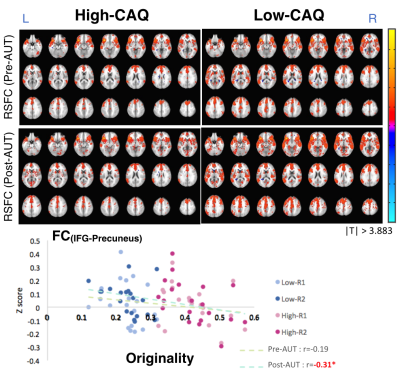5565
Creativity Performance Reflected on the Activation of Divergent Thinking and Connectivity of Inferior Frontal Gyrus1Institute of Biomedical Electronics and Bioinformatics, National Taiwan University, Taipei, Taiwan, 2Department of Psychology, National Taiwan University, Taipei, Taiwan, 3Department of Biological Science and Technology, National Chiao Tung University, Hsinchu, Taiwan, 4Graduate Institute of Humanities in Medicine, Taipei Medical University, Taipei, Taiwan
Synopsis
Creativity is taken as a spontaneous mental process and creativity scales associates with resting-state functional connectivity in literature. However, it remains unclear that how brain integrity changes following creative thoughts. Targeting on this causal effect, we explored the functional connectivity before and after the engagement of divergent thinking. We demonstrated the interactions between brain activations in divergent thinking and functional connectivity in certain networks, especially in the locus of left inferior frontal gyrus (IFG). Meanwhile, the reduced IFG-precuneus connections could benefit the creativity performances.
INTRODUCTION
The origin of creativity in the brain has been a long-time puzzle to neuroscientists. Even though creativity performances can be measured by the approximates of divergent and convergent thinking, the time to reach the ‘eureka’ moment is unpredictable and requires mind-wandering 1. Therefore, recent studies found that the spontaneous synchronizations within default-mode network (DMN) associate with the creativity behavioral scores 2,3, but how DMN assists divergent thinking remain unclear. Therefore, we investigated the causal effect of divergent thinking by alternative use task (AUT) on resting-state functional connectivity (RSFC).METHODS
Forty young healthy participants (20 female, 20-30 y/o) were recruited to fill creative achievement questionnaire (CAQ) and scanned in a Siemens 3T PRISMA scanner. The creativity task AUT is to come up with the alternative usage of 20 items within 20 seconds, lasting for 15 min. As shown in Fig.1A, the experiment included 2 resting sessions, before (pre) and after (post) AUT for testing the causal effect on RSFC. All the functional images share the same protocol setting: TR= 2 sec, TE= 35 ms, FA= 84°, thirty-seven axial slices (FOV = 220×220 mm2, 64×64 in-plane matrix size, and 3.4 mm thickness. Participants were assigned into high-CAQ (n=20) and low-CAQ (n=20) for group-comparison. The AUT performances were evaluated and scored in originality and Fluency. Functional images were preprocessed using AFNI in standard procedure. We performed the group comparison by 2-sample t-test, and then using the contrast as the seed in RSFC analysis. For DMN, we placed the seed at posterior cingulate cortex (PCC, [3,-53,26]) and then performed 2x2 mixedANOVA for group and AUT effects.RESULTS
Figure 1B and 1C show the group comparison of brain activations in AUT for high-CAQ and low-CAQ, respectively (FWE-corrected p<0.05), with left-side lateralization on the frontal cortex. Relatively, low-CAQ group demonstrated weak activation, and the maximal contrast was found in the left inferior frontal gyrus (IFG, [-36, 24, -14]). Seeding at IFG resulted in a network resembling salience network. Figure 2 demonstrated the RSFC outcomes for the 2x2 factors. In contrast to the AUT results, high-CAQ group showed less degrees of IFG-based connectivity than low-CAQ, especially in the post-AUT RSFC. Specifically, the IFG-precuneus connectivity showed negative correlation with the AUT originality (Fig.2 bottom panel). The negative correlation was not prominent in pre-AUT condition (r=-0.19), but the association became significant in post-AUT (r=-0.31, p<0.05). The PCC-precuneus connection in DMN was elevated after AUT, but this connection did not associate with either AUT originality or fluency.DISSCUSSION and CONCLUSION
We discovered that divergent thinking indeed affects the functional connectivity in both DMN and salience network, and such RSFC changes might be the indication of creativity enhancement. The AUT activity and network connectivity demonstrated interactions by the following observations: (1) high-CAQ group showed stronger activation but weaker connections in general; and (2) IFG-based network showed negative associations with the AUT originality after the engagement of divergent thinking. Future studies are warranted to investigate the automatic process underlying creativity incubation.Acknowledgements
This study is supported by Taiwan Ministry of Science and Technology (MOST 105-2628-B-038 -013 -MY3 and MOST 106-2410-H-038 -003) and Taipei Medical University intramural grant (TMU105-AE1-B11).References
1. Ritter, S. M. (2014). Creativity—the unconscious foundations of the incubation period, 1–10.
2. Beaty, R. E., Benedek, M., Wilkins, R. W., Jauk, E., Fink, A., Silvia, P. J., et al. (2014). Creativity and the default network: A functional connectivity analysis of the creative brain at rest. Neuropsychologia, 64, 92–98.
3. Kühn, S., Ritter, S. M., Müller, B. C. N., van Baaren, R. B., Brass, M., & Dijksterhuis, A. (2013). The Importance of the Default Mode Network in Creativity-A Structural MRI Study. The Journal of Creative Behavior, 48(2), 152–163.
Figures

